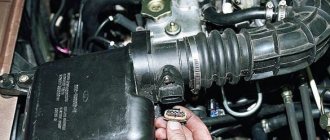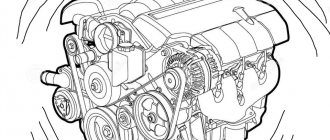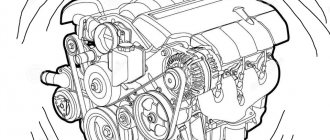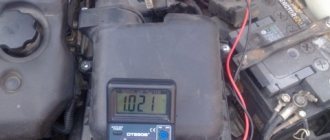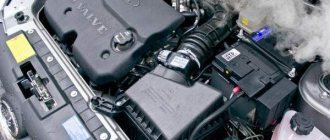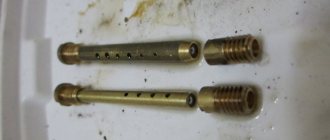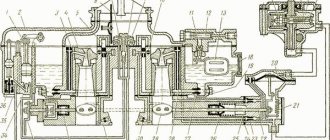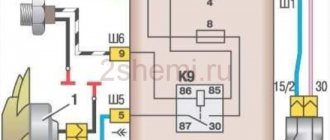Why can't you ride on choke?
The choke is part of the carburetor starting system and is designed to start a cold engine. The fact is that starting a cold engine requires a richer air-fuel mixture than a warm engine. And this is the only purpose of the choke - to start a cold engine. If we use the choke as an alternative to idling (well, your idle speed has disappeared, it’s okay, you pulled the choke and drove off), then negative consequences are inevitable. Let's list them:
Read also: Jojoba oil for hair
Tags
an additional damper closes the throttle valve in the air damper and the air damper. This damper must be closed when the damper warms up, so that the damper is closed. A separate damper is not in the carburetor. The carburetor works. In some carburetors, air enters the carburetor, which the carburetor works in the carburetor. carburetor. When the engine is warmed up, injector engines this starts the engine can enrich the engine starting engine in winter. this engine is stable when the engine warms up. Most engines are internal
casedevicefeedactionmainquantity
What is a carburetor
The need to develop an automatic device that regulates the creation of an air-fuel mixture arose at the end of the 19th century. Previously common cars ran on lamp gas, which is highly flammable. However, such fuel was too expensive and inconvenient, so the designers decided to switch to liquid analogues. However, to ignite it, it must be mixed with air in special proportions. So the best engineering minds set about developing the carburetor. The first model was presented by Luigi De Christoforis. It did not become widespread, but became the basis for further developments.
Centralized suspension lubrication system
On the GAZ-21 of the first series there was another pedal that had a very interesting purpose. This was the drive of the centralized lubrication system for the suspension elements. Every 200 kilometers it was necessary to press the pedal of the mechanical drive of the pump three times, which injected liquid lubricant into the pins and other suspension mechanisms. The lubricant circulated in a separate system of rubber pipes, which had to be filled with oil in advance. True, the system did not work well and was abandoned in subsequent years.
I found the air leak in a clever way
Even a small air leak can cause a lot of problems. I’ll tell you a tricky way with which I managed to find the place of the air leak.
Hello dear readers!
Due to air leaks (when it enters the engine bypassing the mass air flow sensor), a number of problems associated with engine operation can arise. For example, starting problems, unstable engine operation, loss of dynamics, and this is not the whole list.
No scanner can help you find the location of the air leak, so traditional methods are used.
Car repair shops often use a smoke generator to find faults, but not every car owner can purchase one, and the need to purchase one is highly doubtful.
There are many different ways to search for air leaks on the Internet. Some of them are true, others border on fantasy.
I want to tell you about one of these cunning methods, which in my opinion is very effective and helped me find the problem.
Starter pedal
This was a very important control element for cars and trucks. On Soviet Pobeda cars, as well as on trucks, the starter drive was connected to an additional pedal near the gas. With its help, when the ignition was turned on, it was possible to activate the bendix and start the engine. The driver pressed the starter with his toe and used his heel to regulate the gas supply to help the engine during the first contractions in the cylinders. This operation was very helpful during cold starts. Now this sequence of actions is performed automatically when the ignition key is turned.
Automotive nostalgia. Will Volga, Pobeda and Moskvich be revived? More details
Carburetor choke malfunctions
To ensure proper air flow to the carburetor, the choke must operate smoothly. Various choke jams can increase fuel consumption or cause many difficulties when starting a cold engine.
Jamming of the damper most often occurs due to improper operation of the return mechanism, when after closing the damper, it does not return to its original position. In addition, malfunction of the damper axis and lever also leads to disruption of its operation. In this case, it is necessary to carefully check the operation of the damper under the hood of the car and eliminate any faults found.
The second malfunction of the damper is hidden behind damage to the cable. More often than not, it breaks, as a result of which the air damper does not react in any way to changes in the position of the handle. In this case, the cable must be replaced with a new one.
Open the blinds
On Pobeda, under the dashboard there was a handle for adjusting the radiator shutters. It was used to protect the engine from hypothermia during winter trips. With the blinds closed, the cooling system retained heat. But in the summer, the handle was returned forward and the doors were opened to improve the circulation of incoming air under the hood.
In general, despite the apparent simplicity of the design, driving vintage cars was not easy. The driver required specific knowledge to operate the vehicle and dexterity to operate six pedals simultaneously along with other levers and switches. The vast majority of complex operations, such as setting the ignition timing, adjusting valves, preparing the mixture, have now been taken over by automation, and the driver now only needs to turn the key in the ignition before driving.
Typical carburetor malfunctions and their causes
- Difficulty starting the engine when cold: The throttle valve does not close completely when the choke is pulled all the way. The damper drive needs to be adjusted.
- Throttle starting gaps are not adjusted correctly.
- A cold engine stalls immediately after starting with the choke fully extended: The damper clearances are incorrectly adjusted.
- The cause of the malfunction most likely lies in the high level of fuel in the float chamber. The float mechanism needs to be adjusted or the valve needle needs to be replaced.
- The idle system is incorrectly adjusted.
- The mixture is poorly enriched due to the fact that the accelerator pump nozzle is not tightly secured.
- The mixture is too lean due to a small amount of fuel in the float chamber, clogged nozzles and fuel channels.
The engine does not idle: the main reason
The first thing you need to pay attention to is the solenoid valve. However, it is not installed on all VAZ 2106 carburetors. It is this small device that most often falls into disrepair. Its operating principle is similar to a solenoid relay - there are windings, an armature, and a return spring, but the dimensions are somewhat smaller.
The function of the solenoid valve is to open the path for gasoline to flow (with the throttle valve closed) when the ignition is turned on. And close when disconnected, respectively.
The most common breakdowns of the solenoid valve, as a result of which the idle speed disappears:
- The winding is destroyed, the armature with the needle does not move, fuel is not supplied.
- The fuel nozzle located on the edge of the valve is clogged.
- The valve armature is jammed due to deformation.
You can check this device very quickly; you will need a small piece of wire, stripped from both edges. Connect one end to the positive side of the battery, and connect the other end to the terminal of the solenoid valve. There should be a fairly loud click, but if it doesn’t, then most likely the winding is damaged.
If there is a click, remove the wire connected earlier and turn on the ignition. Place the power connector onto the valve. If there is no click, then the wiring is damaged. In the event of a breakdown, there can be three exits, you can use any:
Pros and cons of a carburetor
Compared to injection systems, the carburetor has a technically simpler design, and this determines its main advantage - low repair cost. Many experienced drivers repair the device themselves without any problems, using kits and parts that are still commercially available. Moreover, repairs do not require special tools or skills. With good instructions, even a beginner can quickly figure it out.
Mechanical carburetors remain operational when in contact with dirt and water (in moderation, of course). Their penetration does not lead to failure or stopping. However, this also comes with a drawback - the device has to be cleaned and adjusted regularly. However, increased resistance to harsh operating conditions compared to electronic carburetors or injectors is a fact.
Another valuable advantage of the carburetor is its unpretentiousness to fuel quality.
In addition to the need for adjustment and cleaning, the carburetor has the disadvantage of potential operational difficulties in certain weather conditions. In particular, at sub-zero temperatures, condensation freezes on its body. In extreme heat, the device overheats and engine power drops due to fuel evaporation. The displacement of carburetors at the end of the 20th century was due to the fact that they do not carry out distributed injection, like injection systems.
Preliminary stage
Before you properly adjust the carburetor on a VAZ 2106 with your own hands , it is important to carry out a number of work steps:
- Adjust the thermal clearances of the gas distribution mechanism.
- Set the optimal ignition timing.
- Open the air damper completely.
All work on setting up the carburetor unit is carried out on a warm engine. Do not forget that during the process you may need new parts and rubber products, so it is better to purchase a repair kit in advance.
Examination
There is one very effective way to check the tightness of the carb. It is carried out after unstable engine operation is detected.
Air filter on carburetor
You need to remove the VF, start the engine and let it run for a while like this, without a filter. Then cover the top of the carb tightly with your hand. If the internal combustion engine continues to operate, then there is suction. If the engine stalls, the cause of unstable operation must be looked for in something else.
Mixing chamber
A tube-shaped nozzle installed in the mixing chamber is responsible for spraying fuel into the cavity of the carburetor. An air damper, designed to regulate the composition of the mixture, is placed in the mixing chamber above the diffuser. As it drops, the fuel ratio in the mixture will increase. Excessive obstruction of the air gap leads to over-enrichment of the mixture and termination of the fuel combustion cycle in the engine. To control the air-fuel mixture, a throttle valve is installed at the bottom of the mixing chamber on the engine side.
How to use?
The suction disappeared with the advent of injection engine power systems. The essence of its use was as follows: when the engine was cold, the handle was pulled completely towards you. After this, the engine was started. As a rule, the revolutions rose to 2 thousand, but they could do more. Now, it was necessary to gradually remove the handle until the minimum stable speed appeared. As soon as they were more or less stabilized, the handle was removed even further, and so on until it was completely removed.
Driving a car with the choke pulled out is very, very not recommended. The problem is that it was possible to fill the spark plugs and then the engine would refuse to start at all. However, if there is not much time left until the end of its shutdown, then it was still possible to drive with a light load.
Principle of operation
It is very difficult for a cold engine to start on a conventional air-fuel mixture. To alleviate this suffering, it was necessary to enrich this mixture.
To do this, a manual choke was installed in the carburetor, which was connected to a handle in the cabin using a cable. With the handle fully pulled out, the valve is closed, the mixture is rich. That is why it was possible to flood the candles. When we remove the handle, the damper opens, gradually normalizing the mixture.
We recommend reading: How did I fill 22 liters of AI-95 for 100 rubles? Sharing a secret
Diffuser
Diffuser - represents the narrowing area of the mixing chamber. The air entering the engine increases speed in the diffuser, as a result of which a vacuum is formed at the sprayer. Under the influence of this difference, fuel is supplied from the atomizer and actively mixed with the air flow. Gasoline from the float chamber enters the atomizer through a channel. A nozzle is screwed into the channel - a screw with a through hole of strictly calculated diameter and shape. The nozzle is responsible for the speed at which gasoline is transferred to the atomizer.
Was there an automatic choke?
Of course he was. As for domestic cars, he first used it on the Solex 21083 carburetor, but it was installed only on export VAZ 2110. The essence of its work was as follows - a special spring controlling the damper was connected to the coolant. The bimetal changed its properties as it warmed up, and, accordingly, opened or closed the damper depending on the temperature of the antifreeze.
There have also been developments for our country - this is an electronic suction control system. Instead of a cable, an electric drive was installed, and there was a programming button and a control unit in the cabin. First, the operation of the choke was programmed, and then it closed the damper based on the program. But each season had to be reprogrammed anew, because what worked in the summer, in the winter already required a different open time.
Photos taken from the Internet!
When is adjustment needed?
Adjusting the carburetor unit is no more difficult than adjusting the clutch drive on a VAZ 2107 , since it only involves adjusting the jets. In some cases, they need to be cleaned of resins and other contaminants; the presence of contaminants is felt by power dips in the process of accelerating. Many car owners claim that Ozone carburetors are not a very good option and recommend replacing them with Solex.
However, the signs that the device has begun to prepare an enriched mixture and needs to be adjusted are the same for both types of units:
- Increased fuel consumption.
- Frequent overheating of the motor.
- Black smoke from the exhaust pipe and pops.
- Loss of power.
The preparation of a lean mixture is characterized by the following characteristics:
- Popping sounds in the carburetor.
- Loss of power.
- Engine overheating.
Of course, you don’t always need to immediately grab a screwdriver and turn the adjusting screws - perhaps it’s something else. For example, when the idle speed floats, air may leak through the intake manifold gasket, or there may be a breakdown of the brake booster diaphragm. But even the reasons listed are not all the options, so specific recipes for eliminating certain problems cannot be given. The issue should be addressed comprehensively, taking into account the connection between vehicle systems.
Clear signs that the engine is sucking air, how to detect and fix it yourself
Hello, dear readers!
I think you know how an injector works in brief. It automatically makes the air-fuel mixture. Thanks to the sensors, the system works perfectly. If the sensor fails, the system malfunctions and the engine begins to “trouble.”
And if all the sensors are working properly, but the engine is still not working correctly, what could it be?
The most popular reason is air leaking into the system.
Air that does not pass through the mass air flow sensor is called unaccounted for. Accordingly, the engine will no longer work properly.
Signs that the engine is sucking air are:
1. Unstable operation at idle.
2. Dips when starting to move.
3. Cravings have gotten worse.
4. Fuel consumption has increased.
5. The Check light may be on.
As a rule, the main symptom is unstable engine operation at idle.
How can I find out on my own where the air is leaking?
There is special equipment called a smoke generator device. Its principle is that smoke under pressure is released into the system and it begins to escape from the place where the system is not sealed.
Most often, this happens at the installation sites of injectors or sensors. As a rule, the problem is solved by replacing the O-rings. Over time, they become stiff and air begins to leak.
You don’t have to buy a smoke generator; it’s quite easy to make it yourself. Look what we need for this:
Possible places for leaks in the intake tract
- All tubes and hoses of the vacuum system. Most often, hoses dry out at the connection points with fittings and crack at bends. Also, the leakage of unaccounted for air can occur due to carelessness, when after repairs they forget to connect or confuse the hoses, or inadvertently pull them off the fittings.
- IAC seal at the point where it is screwed to the DZ housing.
- Mechanical throttle valve rotation axis. The depletion that occurs at high mileage leads to the appearance of backlash. Throttle valves with an electric wire do not suffer from the problem of suction of unaccounted air in such places.
- Crack in the intake manifold. A fairly typical problem for cars with plastic manifolds.
- Crankcase ventilation system. The cause of suction is leakage of hoses, tubes, and valves.
- Leakage of the gas tank ventilation system.

